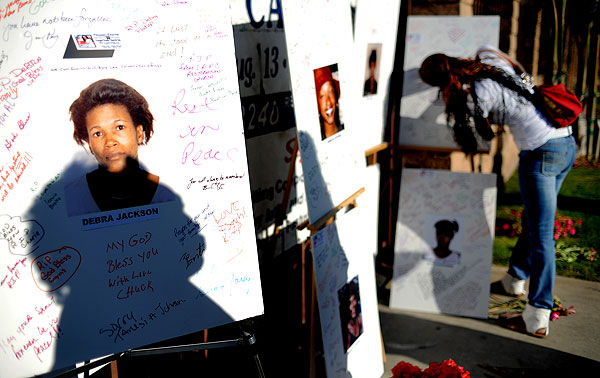Times coverage: Friends recall Debra Jackson's disappearance and death 25 years later

Tuesday marked the 25th anniversary since the body of Debra Jackson, 29, was found in an alley near West Gage Avenue in the Vermont-Slauson area, the first known victim of a serial killer later known as the Grim Sleeper.
At the time of her death, Jackson, a trained beautician who was working as a waitress, had been close to regaining custody of her three young children.
The Times sat down with her friends, Leo and Elizabeth Anderson, to talk about the evening they last saw Jackson, the first alleged victim of Lonnie Franklin Jr., who has also been charged with the murders of nine other women and the attempted murder of another.
Sarah Ardalani has their story:
Elizabeth and Leo Anderson distinctly remember when Debra Jackson walked out of their home on the evening of Aug. 10, 1985. It was the last time they would see their friend, the first known victim of a South Los Angeles serial killer who came to be known as the Grim Sleeper.
Elizabeth Anderson was in the kitchen cooking chicken for dinner when Jackson told her she needed to run an errand: meet up with someone to repay a loan.
For five years, the Andersons had taken in Jackson, a trained beautician who was working as a waitress at the time. She had moved into the Willlowbrook home with the married couple and their four children in 1981, not long after losing custody of her own children while living with an aunt in South Los Angeles.
Elizabeth did not understand why Jackson needed to go right then. The memory has remained vivid for 25 years, made more so by the recent arrest of Lonnie Franklin Jr., who has been charged with Jackson's slaying and the killings of nine other women over a span of more than two decades in the South Los Angeles area.
"I told her, 'You can wait and pay them in the morning,'" she recalled.
Leo remembers chiming in, "I don't think you should go out there. Wait till tomorrow."
Jackson said it could not wait; payment had to be made that night.
"There was something about it; it didn't make sense. She was determined to leave," Leo said.
Jackson walked out of the house, and Elizabeth followed her.
"You don't have to take the bus, I'll drive you," she said, but Jackson declined.
The two friends embraced. Jackson promised to be home by 10 p.m.
Elizabeth watched Jackson walk down the street until she disappeared.
Read more: Misgivings before a young woman's disappearance
Photo: A woman, right, signs a poster board of one of the victims. Debra Jackson, pictured in foreground, was the serial killer's first known victim. Credit: Wally Skalij / Los Angeles Times
Post a comment
Before you post, here are some answers to frequently asked questions:
Remember, all posts are approved by a Times staffer. Profanity and personal attacks will not be approved.
Four reader comments